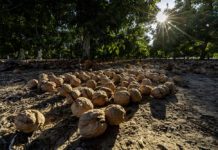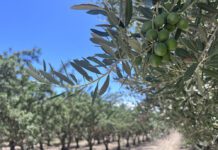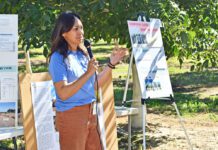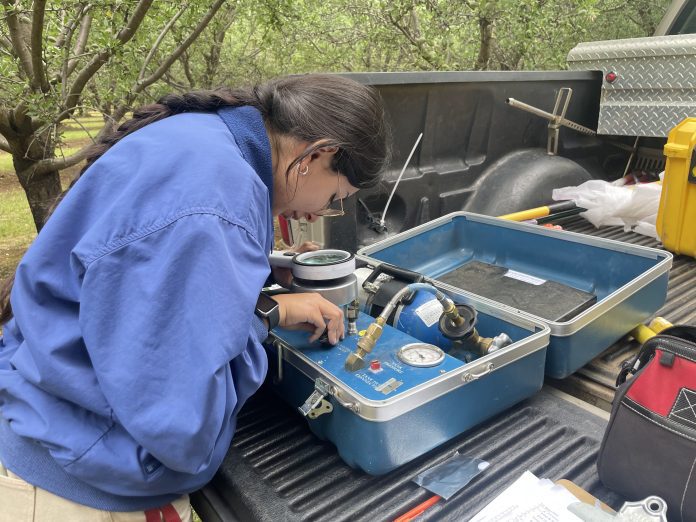
A robust discussion on irrigation scheduling, tools, benefits of adopting new technology, along with decision making advice was provided by experienced panelists at the California Walnut Conference.
When to initiate irrigation, how much water to apply and how often are standard debate topics among walnut growers. While answers to these questions vary with location and soil type, growers are always seeking to improve their water management and ensure nut quality.
Use of the pressure chamber has been a game changer with walnut irrigation scheduling, Tehama County walnut grower and packer Hal Crain said.
“You are getting actual information from the tree. If we can get that in real time, there will be huge benefits. It has brought us to a new level of irrigation management.”
Crain said use of pressure chamber in walnuts can be optimized if indicator sites in the orchard are identified. Labor can be an issue at first, but less will be needed as site mapping moves forward.
A UC ANR publication notes that when used correctly, a pressure chamber can help growers and consultants save on irrigation costs and improve orchard health. It measures plant water tension by applying pressure to a severed leaf and stem enclosed in an airtight chamber. The pressure required to force water from the stem equals the water potential and is measured by an external pressure gauge.
Josh Barton of Barton Orchards in Stanislaus County said he uses several tools for irrigation scheduling, including aerial imaging, tensiometers, a pressure chamber and CIMIS data. The beauty of the pressure chamber, he said, is that the data from it can be compared with other sources. As long as you are consistently checking, the pressure chamber is the most cost-effective tool, he said.
Understanding Trends in Weather
Scheduling improves, Barton said, when there is an understanding of trends in weather and tree use. Over time, he said, you become familiar with orchard water use and can compare with pressure chamber readings and determine optimal timing for irrigations.
The stem water potential readings from a pressure chamber used with evapotranspiration data pull the plant’s water needs together. The pressure chamber readings help growers hone in and be more precise with irrigation.
Water stress, caused by underwatering or overwatering, is a known factor impacting walnut kernel quality. Curt Pierce, panel moderator and UCCE irrigation advisor, noted the importance of using available tools to guide irrigation scheduling and run times to prevent water stress. Overwatering walnuts is the No. 1 cause of darkened kernels, Crain confirmed.
“We see too little or too much water. It can be traditional water use, but is a huge stressor,” Crain said. “More water isn’t always the solution.”
Ken Shackel, pomology specialist at UC Davis, said edible yield in walnuts improves meeting tree water needs. Mild water stress tends to produce somewhat darker kernels, but overwatering results in bad-tasting nuts. Answering a question from the audience about correlation between kernel color and irrigation scheduling, Shackel said the full ET does not have to be applied in walnuts, and that half of ET by end of season could be sufficient.
“The trees may surprise you when you check and the water status is ok but you haven’t applied the full ET,” Shackel said. The main roots are in the top three feet, he explained, but roots can go down 20 to 30 feet and trees may be tapping into moisture there.
Allen Fulton, UCCE irrigation and resources advisor emeritus, said that 50% ET may be a ‘best case’ scenario with orchards closer to rivers or streams. In west side locations with shallower soils, the fraction declines, and 85% ET may be more likely.
“There is a lot of range,” Fulton said.
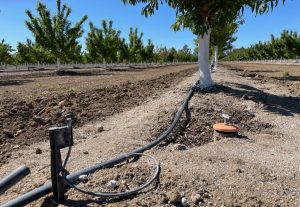
Grower Capability Matters
Intermittent irrigations can also be beneficial to tree health, Barton said. Number of acres and soil types will have to be considered for a grower to accomplish that type of scheduling, he said.
There can be an issue with ideal irrigation timing and what a grower can do, panelists agreed.
“We all have unique situations with our orchards. Number of acres, system capacity and timing are all factors. You have to make the best decision for you,” Barton said.
Crain said that in general, breaking up irrigations can be a good idea; the most benefit from pulse irrigations would be where application rates are heavy. Soils with a lower intake rate are good candidates for pulse irrigations, Fulton said.
Getting the irrigation amounts and timing right will also help with edible yield. Mild stress can result in somewhat darker kernels, Shackel said, but overwatering negatively affects kernel flavor.
Technology overload (the number of products and services designed to help with irrigation) can cause struggles, panelists agreed. Pierce shared his experience at a farm call where irrigators had access to scheduling tools but lacked instruction on use.
There is a lot of new technology out there, Fulton said, but orchard size, variability in orchard sets and limited time for irrigation management pose barriers to use. He suggested one solution would be to identify orchards that use the most water but don’t perform to expectations and use your time to explore reasons why.
“Sort out which technology fits your needs. Every technology has strengths and weaknesses.”
Barton said his first consideration with new technology is to determine the intended use. It also must be user friendly and allow for easy interpretation of data.
“We all want data, but interpreting it can be a challenge,” he said.
Using soil moisture monitoring as an example, Barton said the system is very accessible, and depending on how you cater your platform to your operation, you can use GPS to give an overview of tree status by hovering over sensor sites. The information is used as a management tool and delivered to the irrigators. Another benefit, he said, is weather station data that can be extrapolated. Ability of the irrigator and moving information down the chain of command is also important, Crain said.
Regional versus site-specific CIMIS estimates may also be an issue in determining irrigation scheduling, Pierce said. Shackel said he did not think there would be much variation as using spatial CIMIS would give the best estimate for a specific location.
Tree Needs a Priority
Answering an audience question about turning off water when windfall nuts begin to hit the ground, Barton said at his operation, they began windfall harvest, picking up those nuts so irrigation can resume. Late-season irrigations are still necessary to ensure quality, he added. Late-season stress can impact quality, Crain confirmed. Meeting tree water needs should be a priority.
Addressing a remote sensing question, Barton said this technology has come a long way since he began using it 12 years ago.
“You have to ask yourself, ‘What is the intended use?’” he said. “Is it to improve production, promote tree health or use less water?”
Walnuts have been a challenge with some of the remote sensing devices, Crain said, but he has been persistent in overcoming these, and he thinks they could become valuable tools in the near future.
Stem water potential has been a challenge to measure for about 100 years, Shackel said.
“The new technology is great, but use the bomb as a check. Keep it in your back pocket.”

Cecilia Parsons | Associate Editor
Cecilia Parsons has lived in the Central Valley community of Ducor since 1976, covering agriculture for numerous agricultural publications over the years. She has found and nurtured many wonderful and helpful contacts in the ag community, including the UCCE advisors, allowing for news coverage that focuses on the basics of food production.
She is always on the search for new ag topics that can help growers and processors in the San Joaquin Valley improve their bottom line.
In her free time, Cecilia rides her horse, Holly in ranch versatility shows and raises registered Shetland sheep which she exhibits at county and state fairs during the summer.







